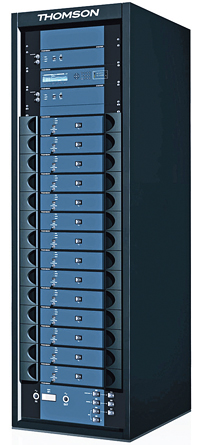Thomson Improves WMBC-TV's Reach With Single Frequency Net

Thomson Elite 1000
NEWTON, N.J.—WMBC-TV covers news and community affairs, and serves a niche audience in Asian and other ethnic communities. We made the digital transition prior to the June 2009 mandate, and began investigating ways to enhance our coverage in strategic target areas of New York City, including specific areas in Queens and Brooklyn that experienced shielding problems from tall buildings.
TRANSMITTER/FREQUENCY MOVE?
We figured that we could improve coverage by either moving our main DTV transmitter from its Montclair, N.J. site or by changing to a different frequency. However, either option would have required a lot of time, and the transmitter move would also be very costly. Our third option was to implement a single frequency network (SFN) by adding a second transmitter at a different location to make up the signal deficiencies. Of course, this also required FCC permission and we worked closely with our consulting engineering firm to come up with a design that would meet all of the FCC's stringent coverage and interference requirements. When the dust finally settled, we were granted a license to operate an SFN transmitter at the Empire State Building with a 90 kW ERP.
As both transmitters would be operating on the same frequency, they had to be synchronized to minimize self-interference. We upgraded our existing Thomson Broadcast DCX Paragon transmitter for SFN compatibility, and added a new Thomson Elite 1000 solid-state unit. We opted to fit both transmitters with the ADAPT-IV exciter and to use Thomson's FPGA and PowerPC technologies, which will allow us to make upgrades and improvements easily and cost-effectively. Thomson Broadcast also provided SFN multiplexing, with the installation of a Thomson Video Networks NetProcessor 9030 at our studio location to manage the necessary SFN timing information of the two transmitters.
THROWING THE SFN SWITCH
Thomson supplied system setup and commissioning for the project, with third-party verification of system timing at several sites in the WMBC-TV coverage area. On completion of the installation and proof of performance, we made several measurements of the ESB DTV transmitter before going to air. This was necessary to verify that system timing met the consulting firm's design criteria. After this step, we were able to initiate SFN broadcasting.
About a week later, Thomson Broadcast returned with Dennis Wallace of the Meintel, Scrignoli, and Wallace consulting firm to verify RF signal coverage at eight key/preselected sites in the New Jersey/New York area. The team used a custom van equipped to measure multiple parameters. Each site was measured with the main DTV transmitter on and the Empire State Building transmitter both on and off to gauge improvement in signal quality and/or interference. All measurements correlated well with the signal plots and interference predictions from the du Treil, Lundin & Rackley consulting firm.
This was the first implementation of SFN compatibility using both the DCX Paragon and Elite 1000 transmitters, and our successful creation of the SFN illustrates the value of this technology in a situation that many broadcasters have encountered since the switch to digital.
Victor Joo is general manager of WMBC-TV. He may be contacted at vicjoo@wmbctv.com.
For additional information, contact Thomson Broadcast at 800-288-8364 or visit thomson-broadcast.com.
The professional video industry's #1 source for news, trends and product and tech information. Sign up below.
